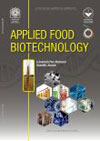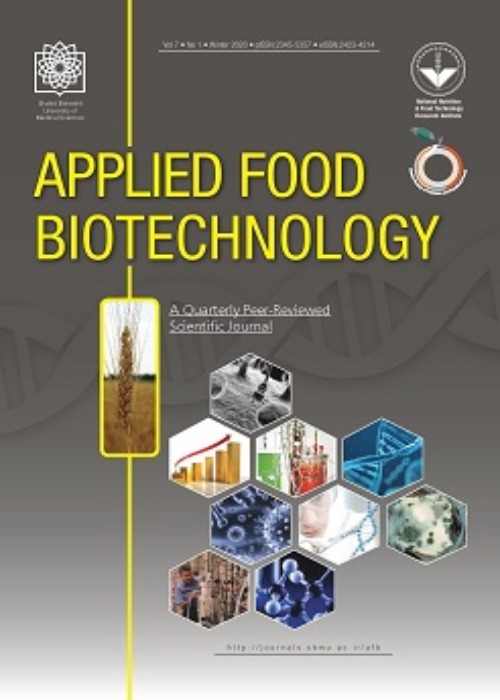فهرست مطالب

applied food biotechnology
Volume:6 Issue: 2, Spring 2019
- تاریخ انتشار: 1397/12/27
- تعداد عناوین: 5
-
-
Pages 91-100Background and objectiveGrowth of beneficial probiotics is attributed to their tolerance to stress factors while most probiotics have a relatively short and unstable shelf life. Bacillus coagulans, an economically important spore-forming species, is becoming increasingly remarkable in field of probiotics for the decrease of harmful effects of processing and environment conditions on the survival of bacterial cells and to assure their functionality in the human body. The aim of this review was to explore scientific research on therapeutic, functional and biosafety properties of Bacillus coagulans as a novel probiotic.Results and conclusionMany scientific literatures have been published on the use of health promoting Bacillus spores in foods. Bacillus coagulans mostly includes several health benefits of non-spore forming probiotics and is able to tolerate heat and stressful requirements of food processing as well as gastrointestinal tract conditions. Considering specific characteristics of spore-forming probiotics, Bacillus coagulans demonstrates a promising potential in production of probiotic foods.Conflict of interestThe authors declare no conflict of interest.Keywords: Bacillus coagulans, Functional foods, Probiotics, Safety assessment, Stress tolerance, Therapeutic aspect
-
Pages 101-109Background and objectiveBacillus spp. with potent fibrin digesting enzymes, especially Bacillus subtilis (natto), has gained favorable insights into the world of cardiovascular health and functional foods. In this study, Bacillus subtilis G8 was isolated from Japanese fermented Natto soybean commercialized in Indonesia. The overall activity of Bacillus subtilis G8 in resolving blood clot was evaluated under variable conditions quantitatively using clot lysis assay.Material and methodsCell-free crude extracts of Bacillus subtilis G8 culture were partially purified with acetone precipitation method. Fibrinolytic activity of the enzymes was verified using fibrin plate assay and zymography. The measurement of clot liquefying activity under physiological temperature and pH was performed using chicken blood. The measurement of clot liquefying activity under physiological temperature and pH was performed using chicken blood. The measurement of clot liquefying activity under physiological temperature and pH was performed using chicken blood.Results and conclusionThrough zymography, Bacillus subtilis G8 expressed four bands of fibrinolytic proteins sized 19 to 30 kDa. Under controlled conditions, a significantly higher clot lysis was seen at 37 and 40°C, compared to lower temperatures (P≤0.05). In contrast, no significant decrease was seen in blood clot at all tested pH (P>0.05). These findings support the use of functional foods for the prevention of blood clot or as a part of blood health restoration.Conflict of interestThe authors declare no conflict of interest.Keywords: Bacillus subtilis, Clot lysis assay, Fibrinolytic, Natto, Zymography
-
Pages 111-117Background and objectiveDetection of microbial pathogens in water is one of the major health issues. Escherichia coli species are used as indicators of fecal contamination in water microbial detection. In this study, efficacies of two methods of multiple tube fermentation and polymerase chain reaction have been compared for the detection of coliforms (especially Escherichia coli) in water.Material and methodsTo compare multiple tube fermentation and polymerase chain reaction methods, 15 water samples were collected from five different sources (three gutter, six well, three tap and three bottled mineral water samples). The samples were cultured in lactose broth media to achieve the most probable number of bacteria. Furthermore, acetate cellulose filter method was used for the bacterial DNA extraction to investigate lacZ (indicating the presence of coliforms) and uidA (indicating the presence of Escherichia coli) genes.Results and conclusionBased on the results of multiple tube fermentation, eight (53.3%) and six (40%) samples were contaminated with coliforms and Escherichia coli, respectively. Furthermore, polymerase chain reaction results showed that ten (66.7%) and eight (53.3%) samples contained coliforms and Escherichia coli, respectively. Results have suggested that polymerase chain reaction is much faster, more accurate and more sensitive than traditional methods (e.g. multiple tube fermentation) for the detection of coliform contaminated water. Moreover, several types of bacteria can be tracked simultaneously by M-PCR.Conflict of interestThe authors declare no conflict of interest.Keywords: Coliforms, Escherichia coli, Freshwater, Multiple tube fermentation, Polymerase chain reaction
-
Pages 119-126Background and objectiveRecently, use of immobilization technology through cell entrapment to entrap biocatalysts has been shown as an economical method since it offers several advantages over suspension cultures such as reusability, high cell concentrations over a period of time, elimination of costly processes of cell recovery and cell recycling and simplifying the downstream processing. Understanding diffusion and permeability coefficients is necessary for the creation of optimized encapsulation systems. The major objectives of the present study included degradation studies on pectin using batch systems using soluble and immobilized pectinase enzymes.Materials and methodsCommercial pectinase enzymes were immobilized using entrapment method for liquefaction of Guava (Psidium guajava L.) pulps with a wide range of applications in food industries. Guava fruit pulps were liquefied using free and immobilized pectinase enzymes to assess the intraparticle mass transfer resistance.Results and conclusionIn the current study, effects of mass transfer on liquefaction process were revealed. Effectiveness factors for the various sizes of immobilized beads included less than 1.0, which indicated that the pectin degradation was a diffusion-controlled process. Effectiveness factors included 0.520 and 0.268 for beads having smallest and largest diameters, respectively. Intra-particle mass transfer resistance was assessed by calculating Thiele modulus (ф) using effectiveness factors calculated for various bead sizes. These results were further used to calculate the effective diffusivity coefficients (De) of guava pulps into the pores. Thiele modulus values (ф) were much higher than 1, which showed that the reaction was very fast and the system was mass transfer controlled. Beads with lower diameters included higher diffusivity coefficients showing a better rate of diffusion of substrates from bulk solutions.Conflict of interestThe authors declare no conflict of interest.Keywords: Diffusion-controlled biochemical process, Diffusivity coefficients, Effectiveness factors, Pectinase, Pectin degradation, Thiele modulus
-
Pages 127-138Background and objectiveBiosurfactants are increasingly used by food industries due to their low toxicities and unique structures. In this study, biosurfactants were produced and characterized for the first time using acidic bacteria isolated from acidic hot springs in Bushehr Province, Iran.Material and methodsScreening and identification of the most efficient species for biosurfactant production were carried out on 12 bacterial species using several experiments such as hemolysis, surface tension, emulsification index and diameter of clear zone. In addition to biosurfactant production, kinetics, stability and structural and thermal analysis were carried out for the bacterial strains using thin layer chromatography, Fourier Transform Infrared, nuclear magnetic resonance and differential scanning calorimetry.Results and conclusionThe biosurfactant from the selected bacteria (0.1 g l-1) was thermally stable at 120°C for 30 min. Stability at temperatures up to 140°C was confirmed using differential scanning calorimetry. The most significant novelty included the fact that the surface property was preserved until an osmolarity of 4% w v-1. Decreased surface tension and the emulsification potential were only reported at concentrations higher the highlighted concentration. Biological assay showed that Staphylococcus aureus was susceptible to produced biosurfactants, while no susceptibility was seen in Escherichia coli. Degeneration of SW480 cell line exposed to 0.601 µg µl-1 of the biosurfactant was detected after 24 h. The structural analysis showed that the biosurfactant was similar to surfactin as a food bioemulsifier.Conflict of interestThe authors declare that they have no conflict of interest.Keywords: Acidic hot spring, Biosurfactant production, Characterization, Extremophile


